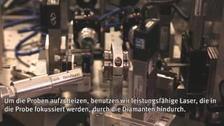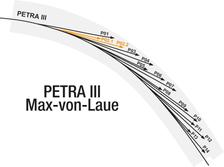P02.2 is the Extreme Conditions Beamline (ECB) at PETRA III. The beamline focuses on harvesting very brilliant X-rays of PETRA III to conduct diffraction experiments at relative high energies on both single crystal and powders and extreme conditions of high-pressure and simultaneous high/low temperatures. The high brilliance in combination with fast area detectors enables furthermore time resolved diffraction experiments at the hundreds of micro seconds time scale.
PETRA III is one of the foremost 3rd generation synchrotron facilities in the world due to its low emittance storage ring that creates a very small and highly brilliant source especially at high energies. Such a source is ideally suited for experiments at extreme conditions since they require hard X-rays with high brilliance and a small focus. The Extreme Conditions Beamline (ECB), is optimized for micro powder and single crystal diffraction at simultaneous high pressure and high/low temperatures in the Diamond Anvil Cell (DAC) and the Paris Edinburgh Press. The ability to create extreme conditions is complemented on both beamlines by time resolved diffraction capabilities in order to explore the kinetics of physical processes such as meta-stabilities during a phase transition.
The above requirements have been realized as follows:
- Offers micro focus of 2 (H) x 2 (V) micron2 (Kirkpatrick Baez (KB) Mirrors) and 8 (H) x 3 (V) micron2 FWHM (Compound Reflective Lenses, CRL) at energies of 25.6, 42.7 (Be lenses). More recently the beamline has also established in collaboration with the BMBF Verbundforschung project from the Uni. of Bayreuth (P.I.: N. Dubrovinskaia) a sub-micron beam (0.8 x 0.8 micron2 at 25.6 keV, see Glazyrin et al. 2022, JSR) to meet the ever growing demands for such focus at high energies.
- Employs fast 2D area detectors from Perkin Elmer (XRD1621) and two GaAs LAMBDA detectors (operating at 24 kHz, partially funded through a BMBF Verbundforschung project from the Uni. of Frankfurt, P.I.: B. Winkler) enables the very fast collection of diffraction images.
- Provides various sample environments to generate high-pressures created in the DAC and simultaneous high/low temperatures. P02.2 consists of two experimental setups, the laser heating (LH, Konopkova et al. 2021 JSR, partially funded through BMBF Verbundforschung project from the Uni. of Frankfurt, P.I.: B. Winkler) and the general purpose (GP) experiment; where the GP experiments accepts all sample environments other than laser heating, e.g. cryostats, resistive heating, and dDAC (Jenei et al. 2019, RSI). Special setup at the GP is a 2 circle diffractometer (2theta/theta) with double sided laser heating for single crystal diffraction at very high temperatures (Bykova et al. 2019, RSI, funded through the BMBF Verbundforschungs project from the Uni. of Bayreuth, P.I.: N. Dubrovinskaia). Latter is not a standard setup at the GP but can be requested from the beamline.








